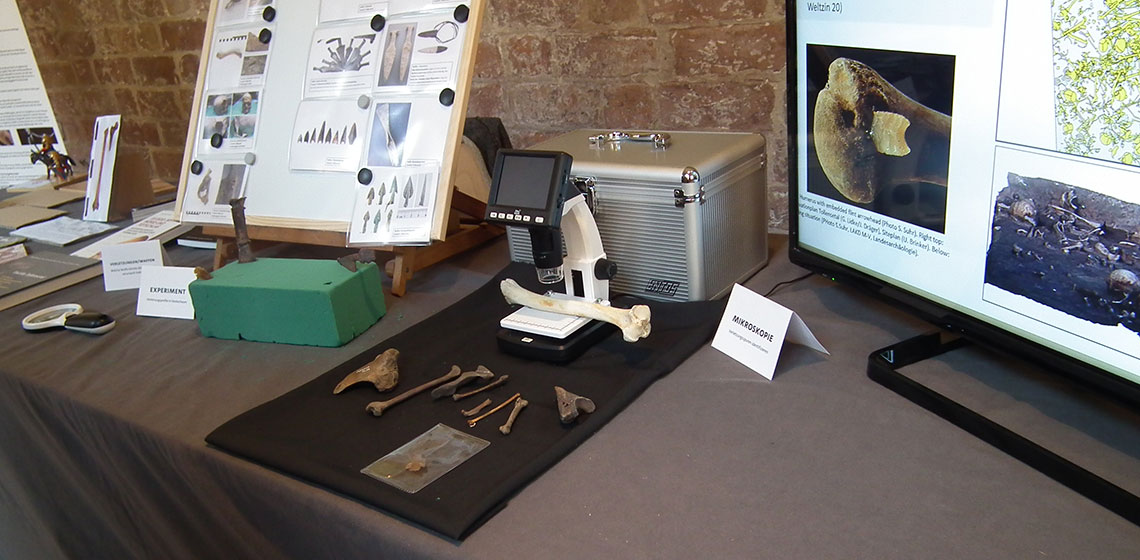
The Archäologisches Landesmuseum in Brandenburg hosted the annual Archäotechnika living history event, during the weekend of 11 to the 13 August 2018.
Every year, the Archäologisches Landesmuseum in Brandenburg hosts Archäotechnika, a gathering of craftspeople and reenactors to display their work and demonstrate their skills. The participants have researched the fine details of the crafts and clothing of the period in which they work. They engage in experimental archaeology to explore how various crafts were performed in order to replicate objects seen in museum exhibits. The result is an impressive gathering of highly skilled crafters exhibiting the culmination of careful attention to detail and practical skills.
In August 2018 the museum’s Archäotechnika event focused on the Bronze Age. Participants used tools and materials, and wore clothes appropriate for the period. For both days the events started with a procession that included playing a small instrument with bronze chimes and the lur, a type of large bronze horn from northern Europe.
A wide variety of crafts were demonstrated, with bronze casting being one of the most popular. Different types of furnaces were in use, including pit furnaces and ‘horseshoe’ shaped ones. Bellows also varied, from bag bellows to the more familiar pump bellows. Along with these were displays of smithing tools made from bronze, antler, and bone. Visitors had the opportunity to see sets of bronze armour, swords, axes, and jewellery, all brightly polished as they would have appeared in the Bronze Age. Archäotechnika presented visitors with a brighter image of the Bronze Age than most museum displays provide. Clothes were brightly coloured using natural fibres and dyes, and bronze ornaments and fittings were brightly polished. This was well illustrated by a Bronze Age fashion show, where participants showed off their recreated clothes and accessories. Notable participants included a woman dressed as the Egtved Girl wearing a string skirt and bronze belt box, and others with textiles made from complex weaving patterns.
A paddock was roped off where two small white horses were kept. During the day their owners demonstrated Bronze Age horsemanship and explained the types of bits and riding equipment that were in use in northern Europe at the time.
During the weekend the demonstrators displayed the results of their research and craftsmanship. One man showed how salt was produced by evaporating a solution slowly in specially made ceramic vessels. Another exhibitor had an extensive display of fishing equipment he made that included nets, weights, harpoons and fishhooks, and weirs and fish traps. Textile arts were also exhibited with participants spinning wool and other fibres, and dying vats of spun yarn using local dye plants. Stone work, including flintknapping and polished stone tools were made while examples of finished tools were displayed. Larger bronze objects, including a sword were cast in the cloistered area, while smaller tools and jewellery were cast on the outer grounds of the building throughout the weekend.
While these activities covered the museum grounds, inside the cloisters archaeologists linked the past with present through exhibits and demonstrations about how archaeological research is performed. Forensic archaeologists explained how bones tell details about an individual’s life, using a microscope to show the small details that give clues as to the person’s health or physical fitness. In another section a loom was set up and textiles were on display that replicated ancient cloth. The study of ancient fibres, along with spinning, and weaving tools provide information for experimental archaeologists to reproduce Bronze Age textiles. This in turn helped other researchers to identify and reproduce composite costume accessories that included bronze beads, studs, and coils. Another display included the lur and other bronze horns with explanations of the complex processes necessary to create them.
Visitors also visited the museum, located on the upper floors of the building. It contains over 10,000 objects that span 130,000 years of cultural history. The Bronze Age exhibit contained such rare objects as a bronze mould for a palstave with the axe still inside, beautifully decorated belt boxes, daggers, swords, axes, ornaments, and a reproduced set of finely decorated golden bowls.
Archäotechnika provided an ideal environment for participants to present their crafts in a living history environment and to demonstrate how objects were made using ancient technology. Visitors had the opportunity to both observe and also have a go at trying a craft or handling archaeological artefacts. In so doing, they gained a greater appreciation of how craftwork was practiced in the past and an understanding of the objects they see in museum exhibits.
The Archäologisches Landesmuseum is located near the centre of Brandenburg. In addition to visitor tours during regular museum hours, the museum also offers workshops, musical events, and “archaeological digs” to educate children on how archaeology is done. For more information regarding this and future events, visit the Archäotechnika web page.